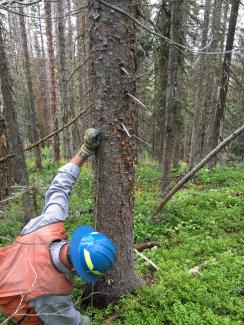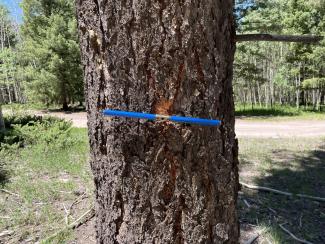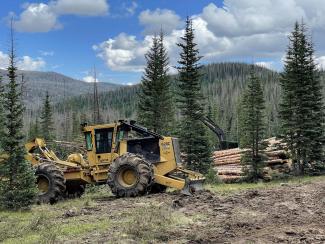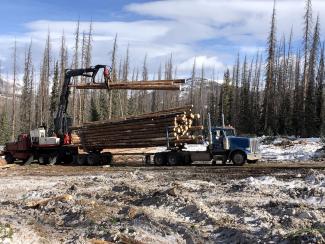Forest Management
The Rio Grande National Forest is covered hundreds of thousands of acres of forested land. These forests are managed for a variety of uses from recreation, wilderness, habitat for wildlife, and for forest products like firewood, as well as for timber to make the many products we use every day.
The forests of the Rio Grande are managed for a variety of objectives from wildlife habitat and fuels reduction, to commercial harvest for timber production. "Forest management" is actively managing forests using scientifically grounded practices to achieve specific outcomes. Tree planting, logging, and monitoring are often associated with forest management activities on the Rio Grande. Timber sales on the Forest must be analyzed to meet regulations so that renewable resources can be sustainably utilized. Forest products contribute to the local and regional economies and communities. Removing any timber or forest products requires prior authorization.
What is forestry?
Forestry is the science and often the art of developing, caring for, or cultivating forests. More traditionally, it is viewed as growing trees to produce timbers.
Forest management is putting forestry into practice. It is the practical application of biological, physical, quantitative, managerial, economic, social, and policy principles to the regeneration, management, utilization, and conservation of forests to meet specified goals and objectives while maintaining the productivity of the forest. Basically, forestry is actively managing forests using scientifically grounded practices to achieve specific outcomes. These specific outcomes must meet laws and regulations and are shaped by the Forest Plan for the specific area being managed.
What rules and regulations must be followed?

Measuring trees can provide data helpful for planning management activities.
Photo Credit: Rio Grande National ForestThe Forest Service Organic Act of 1897 created Forest Reserves that later became lands within the National Forest System. This act had two primary purposes, one to create favorable conditions for waterflow and two, to maintain a continuous supply of timber for the people of the United States. Since this Act, more regulations and policies have been implemented to further outline how National Forest Lands should be managed.
- Multiple Use Sustained Yield Act 1960– This act expanded the number of management objectives for the Forest System Land.
- National Environmental Policy Act (NEPA) 1969 – This act was created to ensure the government makes informed decisions and analyzes and shares the environmental effects of any actions taken.
- National Forest Management Act 1976 – This act governs the administration of the National Forest. It requires each National Forest to develop a land management plan (Forest Plan).
- Rio Grande Forest Land Management Plan (Forest Plan) 2020– Provides a programmatic, high-level framework for what activities can occur and where they can occur on the Forest.
All projects, such as a timber sale and logging operation, must be consistent with the Forest Plan and must meet NEPA requirements. As part of the Forest Plan, a suitable timber base must be established.
Where does the forest management work occur?

Coring trees gives foresters information about a trees age and history.
Photo Credit: Rio Grande National ForestThe Forest is assessed at a variety of scales that range in size from tens of thousands of acres for management areas defined in the Forest Plan, to tens or hundreds of acres at the individual stand level. Individual stands are assessed to determine what type of forest management can occur and is necessary to achieve Forest Plan objectives and to make sure all management complies with applicable regulations and Forest Plan standards and guidelines. Some areas may have no active management, projects, or work done there while other areas may become timber sales or have other active management. If timber is going to be harvested for the purpose of timber production, there must be assurance that the knowledge and technology exist to restocked with trees within five years of the final harvest. Restocking (regeneration) can occur naturally via seed or artificially via planting seedlings by hand.
Much of the forest will never receive any active forest management because it is in roadless areas or Wilderness. Some areas that are not designated as suitable for commercial timber harvest may be managed for other objectives, like mitigating fuels or improving wildlife habitat. Some commercially valuable timber may be removed in projects like this if timber production is not the primary objective.
How are areas chosen for harvesting?
Only a small percentage of the Rio Grande National Forest may ever be actively managed or logged. Managed areas must fall with in specific designations determined by the Forest Plan and these areas must have commercially valuable trees and be accessible.
The Rio Grande National Forest is broken down into many different geographic areas that have similar management emphasis in the Forest Plan – these are called management areas. Wilderness areas and roadless areas not actively managed in terms of timber production and so are removed from consideration.

A log skidder works in the forest.
Photo Credit: Rio Grande National ForestGeneral forest and rangelands areas (Management Area 5 in the Forest Plan) are designated in the Forest Plan as being suitable for active timber management. General forest management areas make up about 45% of the Rio Grande National Forest lands. When this area is further evaluated, portions of it are open meadows or not forested, some areas are too steep to be viably harvested, too hard to regenerate after harvest, and/or are covered by species that are not commercially valuable. When many factors like those are taken into consideration there is about 26% of the Forest that is suitable for timber harvest (for the purpose of timber production).
The spruce beetle is epidemic is visible across the forest as the beetle killed the majority of mature Engelman spruce trees. Most of the beetle affected areas no longer have commercially valuable timber. This reduces the remaining area that may be managed for the primary purpose of timber production by half, to roughly 13%.
The area is again reduced by determining areas that are productive, operable, and have green, live, suitable timber. This leaves about 9% of the Forest that will be further divided into individual treatment units. The individual treatment units are areas that may have a specific project implemented on them such as commercial logging.
Why aren’t all the dead trees being harvested?

Loading logs is a common sight in the forest.
Photo Credit: Rio Grande National ForestThe many of the trees killed by the spruce beetle epidemic are not in areas designated for timber harvest. The majority of dead trees are located in areas closed to timber harvest like Wilderness areas and roadless areas or are in inaccessible locations and areas where it is not economically viable to harvest.
As time passes the dead trees degrade and are no longer commercially valuable. As part of natural processes, the dead trees provide homes for wildlife, shelter for young trees growing up, and will eventually decompose and turn to soil.
The natural cycle continues as seeds left from live trees eventually germinate in the nutrient rich soils and start the long process of growth and playing a critical role on the landscape.
What does the work look like?
The work that happens on the Rio Grande National Forest can be broken into three main categories:
Tree Planting
Tree planning, also called reforestation, generally happens after fires or after a commercial harvest. Seedlings are planted to increase the number of trees regrowing in an area, to increase the speed at which an area will be reforested, or to encourage a specific species.
On average, 50,000 to 90,000 seedlings are planted per year. Engelmann spruce are the species most commonly planted. Seeds are collected locally, catalogued by seed zone and elevation, and stored for later use. Seeds are sent to either the Lucky Peak Nursery in Idaho or Bessy Nursery in Nebraska to be germinated and grown. The seedlings then return to the forest so that the area can be replanted with locally native and appropriate trees.

Planting trees on a post fire landscape.
Photo Credit: Rio Grande National ForestPrecommercial harvest
Precommercial harvest is a forest management tool that is used on 400 and 1,300 acres, on average, annually on the Rio Grande National Forest. Contractors are paid to complete the work as laid out by forest managers.
Precommercial harvest is done for a variety of objectives. Thinning may be done to improve wildlife habitat by increasing grass and shrub lands to improve forage in big game winter range areas or to create more open stands that are preferred by bighorn sheep. Precommercial harvest may also be done to reduce/reconfigure fuels to help reduce the intensity or slow the spread of wildfires. Reducing and/or manipulating (e.g., chipping or masticating) trees can reduce ladder fuels to help create more defensible space. Timber stand improvement may be done to improve the quality and value of trees that will eventually be commercially harvested, similar to weeding and thinning in a garden.
Commercial harvest
Timber sales are purchased and worked by a private companies. Most of the harvests on the forest are done with large equipment and are encouraged to happen in winter when snow helps protect soil and seedlings. On average 44,000 to 68,000 CCF (hundred cubic feet) of wood fiber (timber) has been harvested per year on the forest during a period of time when harvest was increased to utilized dead and dying Engelmann spruce. After the spruce beetle epidemic many of the dead trees were harvested through timber sales, however, as time passes the timber becomes less valuable as it degrades. As the beetle kill degrades a switch is made to live trees and less volume is likely to be sold each year.



